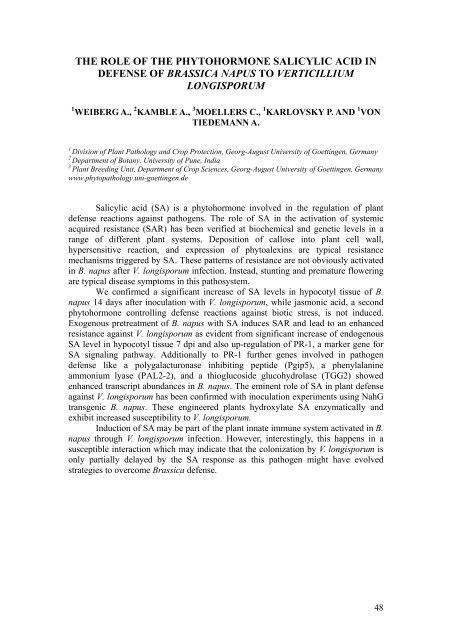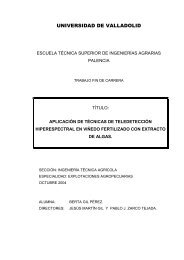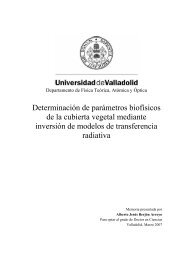10th INTERNATIONAL VERTICILLIUM SYMPOSIUM 16-20 ...
10th INTERNATIONAL VERTICILLIUM SYMPOSIUM 16-20 ...
10th INTERNATIONAL VERTICILLIUM SYMPOSIUM 16-20 ...
You also want an ePaper? Increase the reach of your titles
YUMPU automatically turns print PDFs into web optimized ePapers that Google loves.
THE ROLE OF THE PHYTOHORMONE SALICYLIC ACID INDEFENSE OF BRASSICA NAPUS TO <strong>VERTICILLIUM</strong>LONGISPORUM1 WEIBERG A., 2 KAMBLE A., 3 MOELLERS C., 1 KARLOVSKY P. AND 1 VONTIEDEMANN A.1Division of Plant Pathology and Crop Protection, Georg-August University of Goettingen, Germany2Department of Botany, University of Pune, India3Plant Breeding Unit, Department of Crop Sciences, Georg-August University of Goettingen, Germanywww.phytopathology.uni-goettingen.deSalicylic acid (SA) is a phytohormone involved in the regulation of plantdefense reactions against pathogens. The role of SA in the activation of systemicacquired resistance (SAR) has been verified at biochemical and genetic levels in arange of different plant systems. Deposition of callose into plant cell wall,hypersensitive reaction, and expression of phytoalexins are typical resistancemechanisms triggered by SA. These patterns of resistance are not obviously activatedin B. napus after V. longisporum infection. Instead, stunting and premature floweringare typical disease symptoms in this pathosystem.We confirmed a significant increase of SA levels in hypocotyl tissue of B.napus 14 days after inoculation with V. longisporum, while jasmonic acid, a secondphytohormone controlling defense reactions against biotic stress, is not induced.Exogenous pretreatment of B. napus with SA induces SAR and lead to an enhancedresistance against V. longisporum as evident from significant increase of endogenousSA level in hypocotyl tissue 7 dpi and also up-regulation of PR-1, a marker gene forSA signaling pathway. Additionally to PR-1 further genes involved in pathogendefense like a polygalacturonase inhibiting peptide (Pgip5), a phenylalanineammonium lyase (PAL2-2), and a thioglucoside glucohydrolase (TGG2) showedenhanced transcript abundances in B. napus. The eminent role of SA in plant defenseagainst V. longisporum has been confirmed with inoculation experiments using NahGtransgenic B. napus. These engineered plants hydroxylate SA enzymatically andexhibit increased susceptibility to V. longisporum.Induction of SA may be part of the plant innate immune system activated in B.napus through V. longisporum infection. However, interestingly, this happens in asusceptible interaction which may indicate that the colonization by V. longisporum isonly partially delayed by the SA response as this pathogen might have evolvedstrategies to overcome Brassica defense.48




